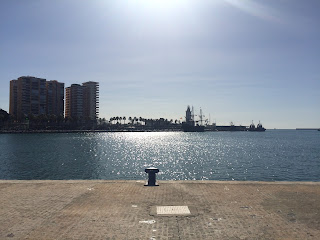Just before the madness of the current Covid crisis, some colleagues-turned-friends decided that a January weekend away would be the ticket for some winter sun. I almost didn't go; Tanzania planning had got the better of me and Paul's moved transplant date was the week after. Gratefully, my arm was twisted.
We left from school on Friday afternoon for a crowded Stansted airport departure, something we've now all grown to miss. Weather reports came flooding in (pardon the pun); parts of Spain were being wracked by Storm Gloria that would go on to kill 14 people, break meteorological records and cause millions of Euros of damage. Despite our doubts that our flight would even be leaving, we arrived, on time, into a storm soaked Malaga several hours later.
As our taxi hydroplaned its way to our Airbnb in the city centre, we noted the dearth of people and slid across the marble tiled city centre. Our accommodation was stunning and very central and gave us an advantageous view of Spanish life below.
The next morning we awoke to the fruits of Laura and Jayne's breakfast foraging of churros con chocolate, bread, meat and cheese from the local market. The weather let up, as in it wasn't pissing down, and so we eventually made for the drizzly streets of a very charming city.
Malaga is very walkable and is home to Pablo Picasso, a Roman Amphitheatre and the Alcazaba, an 11th century castle on a hill.
The rain made an extended visit unviable but we did stop by the Malaga Cathedral and its trees and trees of oranges, many of which had been battered to the ground in the storm.
The aesthetic of Malaga was one to rival every other Spanish city I've visited. Intricate tiled shop signs were everywhere as was colourful graffiti. And although Spain's dominion of empire is long gone, the lasting opulence remains, on the surface at least.
The rain came and went throughout the day. We took these little storms as ample opportunity to duck in to eat and drink our way through the city. From quiet restaurant to little corner bar to buzzing restaurant, we were found some fantastic spots including the Museum of Wine. We arrived almost at closing siesta time but the proprietor fit in a short tasting and we wandered the museum's exhibits, all in Spanish, until they closed. Our wine hostess also gave us some tips for the ensuing day--walk out of the city and do it early--people were going a bit stir crazy and the weather forecast for the next day was looking up.
We spent several hours in Malaga's finer establishments, headed back to the flat to regroup and then hit the town for tapas and live music late into the evening. Nightlife doesn't start early and so we timed it about right. But some of us may have been worse for the wear after a day of day-drinking into night-drinking.
On Sunday the sun came out and this little Spanish city burst to the rafters with life. We made for the port and La Malagueta Beach, a not too far walk from our accommodation. Better, further beaches involved a local bus and time didn't allow for that. As our Malagan wine lady had told us the day before, people were out in droves. It was impossible to get a table for six (or three) outdoors anywhere. The Spanish thrive in the sunshine and love being outdoors. Gloria had hamstrung them.
As Spain has imposed one of the strictest Covid lockdowns in Europe, I think back on our weekend away. If, after a week of being stuck indoors, Malagenans were feeling trapped, I cannot image how they're feeling now. Spanish life, much like many other Southern European nations, is meant to be lived out on the streets, with people, in the sunshine. I send them some of this current British sunshine. I hope we're all out of this soon.














